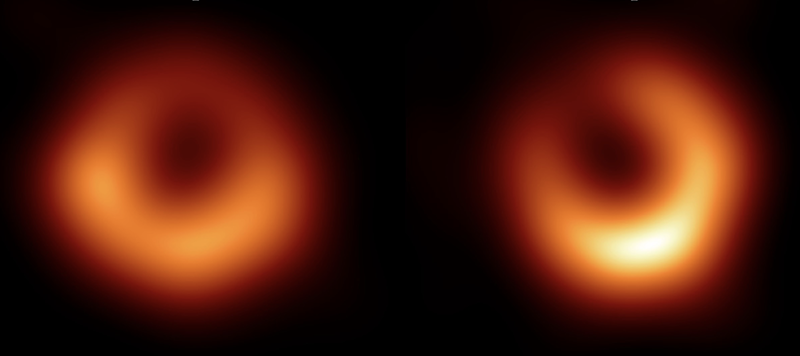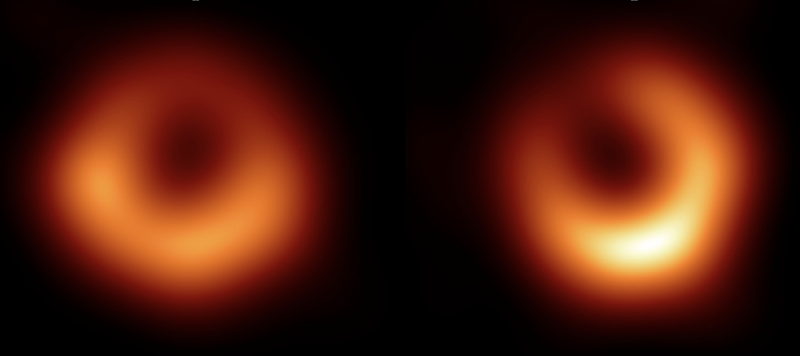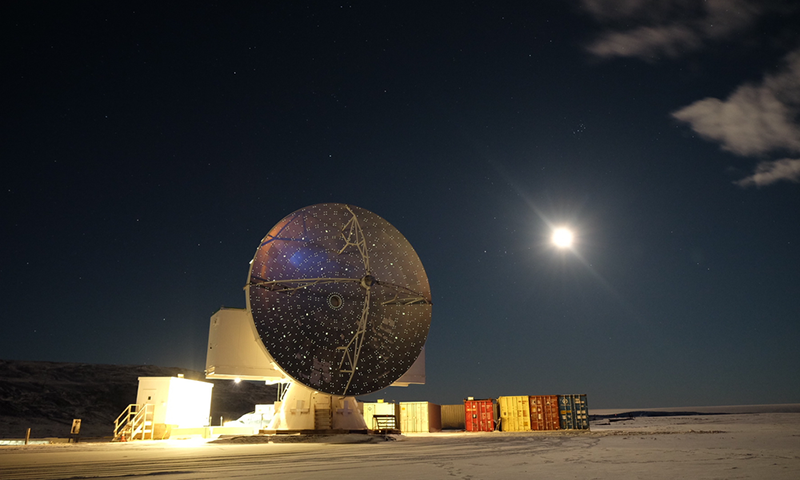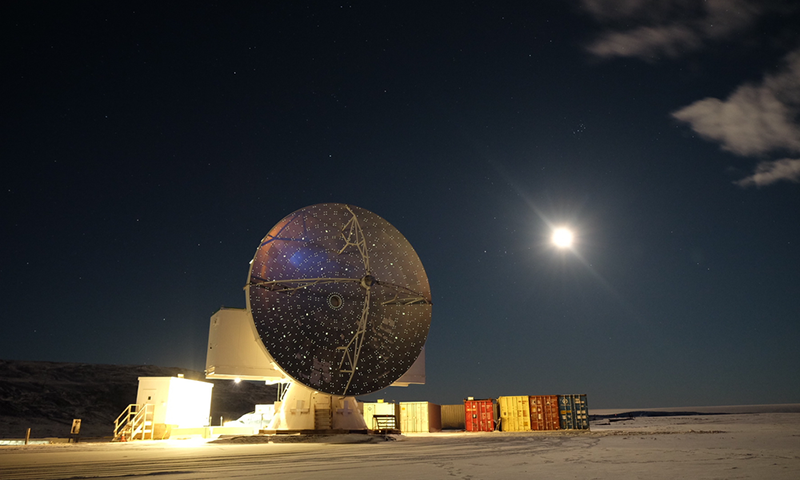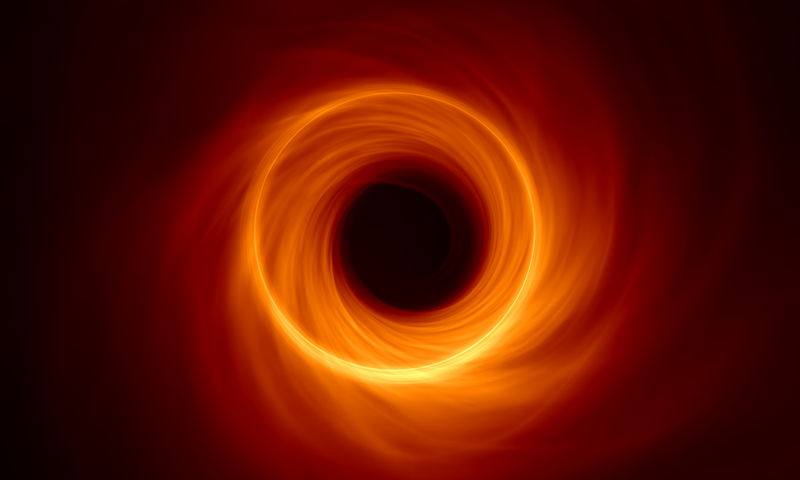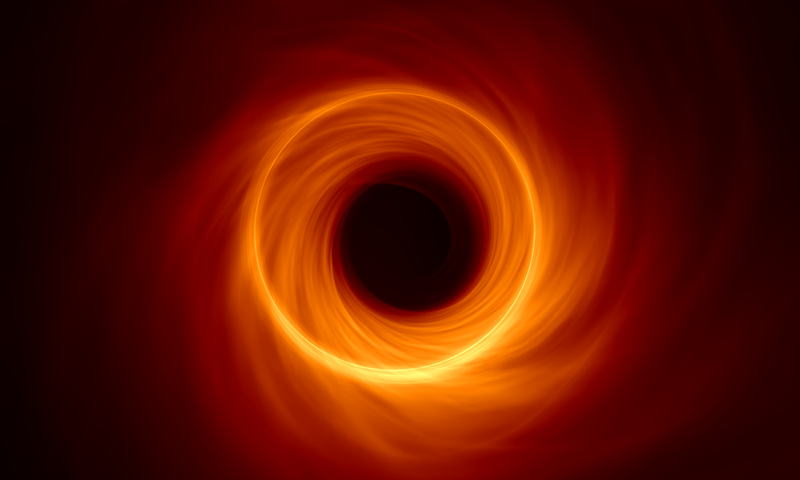Black Hole Portraits Will Become More Frequent
This year marks the fifth anniversary of the release of the first-ever image of a black hole, which revealed the glowing doughnut of the supermassive black hole called M87*. The research team that produced the image—the Event Horizon Telescope (EHT) Collaboration—recently released a second image of that same black hole, which lies 55 million light years from Earth [1]. This image comes from an updated version of the EHT and confirms key features of the black hole while also revealing changes over time in the pattern of light emanating from the disk surrounding the object. Starting with this release, the collaboration expects to issue increasingly frequent updates in support of the newly developing field of black hole imaging.
“Producing the first image of M87* was a herculean effort and involved creating, testing, and verifying many different schemes and approaches to analyzing and interpreting the data,” says Princeton University astrophysicist Andrew Chael, a member of the EHT Collaboration. “Now we are beginning to transition to a point where we understand our instrument and our analysis frameworks really well, so I think we are going to be releasing results a lot more quickly.”
Supermassive black holes are extremely distant and compact objects, two properties that make them extraordinarily difficult to image. For example, M87* appears to us as no bigger than an orange on the Moon as viewed from Earth. The 2019 image of M87* was pieced together using data collected in April 2017 from eight radio telescopes spread across the globe. All the telescopes in that array collected data simultaneously, allowing scientists to treat them as one giant radio-wave detector. The bigger a radio telescope, the smaller the objects it can image, and an Earth-sized detector opened the possibility of observing sources as small as supermassive black holes. So far, the EHT has imaged M87* and Sagittarius A*, the black hole at the center of the Milky Way (see Research News: First Image of the Milky Way’s Black Hole).
For their second data-collection run, which took place in April 2018, the EHT Collaboration added a ninth telescope to the array—the Greenland Telescope—which allowed the EHT array to make more detailed measurements of M87*. The telescopes work in pairs, and the quality of the final image depends on the pair separations and orientations relative to the object of interest. Making a perfect image would require having pairs of telescopes with all possible values of these two parameters. Earth’s rotation provides some additional separations and orientations, but there are still significant gaps in the data. With an extra dish in the array, the team was able to fill in some of these gaps.
Both M87* images show a black disk—the black hole’s shadow—surrounded by a glowing orb, which is the light produced by the material orbiting the hole. The diameter of the black hole’s shadow and the distribution of light in its glowing orb are roughly the same in both sets of data, an encouraging finding, says Nitika Yurk of NASA’s Jet Propulsion Laboratory in California, who is a member of the team that produced the new image.
The diameter of a black hole’s shadow is directly linked to its mass. Other measurements of M87* indicate that the black hole is accreting mass at a very slow rate, slow enough that the radius of its orb should stay constant for the foreseeable future. “We didn’t expect any mass change for M87* over the course of one year,” Yurk says. “It’s really reassuring that the images show that mass consistency.” That sentiment is echoed by all the scientists interviewed for this story, including Lia Medeiros, an astrophysicist at Princeton University and a member of the EHT Collaboration. She notes that replicating previous observations is essential for validating both the observation method and the findings. Seeing this ring-size stability over consecutive years also provides “significant” evidence that scientists correctly understand how black holes behave, she says. “Getting the same result twice may not seem exciting, but for [the collaboration] it was a really big deal.”
The two M87* images do, however, have an important difference: the highest-intensity region of the orb sits in different positions, having rotated 30° counterclockwise between the first and second pictures. This shift fits with general expectations from theory, which predicts that the intensity of emission from a black hole’s turbulent accretion disk should change over time. But following expectations doesn’t make the shift any less interesting, says EHT deputy project scientist Mariafelicia De Laurentis of the University of Naples Federico II, Italy. She notes that there remain many unknowns about exactly what happens in a black hole’s immediate environment. The time evolution of the surrounding magnetic fields and the movement of hot spots within the accretion disk have yet to be fully understood, and both likely impact a black hole’s appearance. “This difference between the 2017 and 2018 observations highlights the importance of continuous monitoring and analysis to capture the evolving nature of black holes and their accretion disks,” De Laurentis says.
The EHT Collaboration is actively pursuing such continuous monitoring both with the current EHT and with next-generation black hole telescopes. In addition to the 2017 and 2018 runs, the collaboration collected data in 2021 and 2022. The array will be collecting data again in April, this time with two additional telescopes. It will also detect higher-frequency radio waves than it has in previous years, increasing the maximum frequency from 230 to 345 gigahertz. This change should increase the resolution by about 30%, Chael says. “It’s not a dramatic increase, but the images should be sharper.”
Two higher-performance telescopes are also in the works, the Next Generation EHT (ngEHT), which, like the EHT, will use only ground-based facilities, and the Black Hole Explorer (BHEX), which will add an Earth-orbiting satellite. As currently envisioned, ngEHT will include an additional 8 telescopes, for a total of 20, allowing the collaboration to fill in more data gaps. This improvement should also significantly increase the array’s dynamic range—the ratio between the brightest and dimmest signals it can detect. This parameter is expected to reach 1000, Chael says, a 100-fold increase over EHT’s dynamic range. That increase could allow the ngEHT to image regions that are further away from M87*’s event horizon, such as the area where a jet of subatomic particles confined in strong magnetic fields is streaming from M87*’s core. This jet has been observed by other telescopes but not by the EHT. “With a higher dynamic range, we could be sensitive to the [jet’s] much dimmer signals” and investigate it more closely, Chael says.
The resolution of the ngEHT, however, is unlikely to be much higher than that of the EHT. But placing a telescope on a satellite could provide a factor of 5 increase in resolution, which should be sufficient to observe a predicted black hole phenomenon called a photon ring around both M87* and Sagittarius A*, says Alex Lupsasca, a black hole theorist at Vanderbilt University, Tennessee, and a member of the BHEX team. Imaging a photon ring is a major goal for black hole physicists, as it could allow them to unambiguously measure the black hole’s spin, a key parameter and one for which there is currently no robust measurement technique. “If we can get high-resolution measurements and high-dynamic-range measurements, that will open up a whole new window on what we can learn about black holes,” Lupsasca says. “Black hole astronomy is entering its high-precision era; it’s a once-in-a-lifetime opportunity to be part of that.”
–Katherine Wright
Katherine Wright is the Deputy Editor of Physics Magazine.
References
- K. Akiyama et al. (Event Horizon Telescope Collaboration), “The persistent shadow of the supermassive black hole of M 87,” Astron. Astrophys. 681, A79 (2024).



